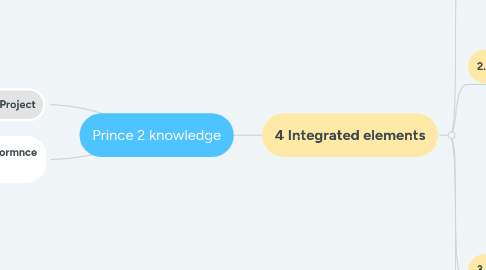
1. The 5 Characteristics of a Project
1.1. 1. Change
1.2. 2. Temporary
1.3. 3. Cross-functional
1.4. 4. Unique
1.5. 5. Uncertainty
2. The 6 Variables (Performnce Targets)
2.1. 1. Costs
2.2. 2. Timescale
2.3. 3. Scope
2.4. 4. Quality
2.5. 5. Benefits
2.6. 6. Risk
3. 4 Integrated elements
3.1. 1. Principles
3.1.1. 1. Continued business justification
3.1.2. 2. Learn from expirience
3.1.3. 3.Define roles and responsibilities
3.1.3.1. 3a Business stakeholders
3.1.3.2. 3b Users
3.1.3.3. 3c Suppliers
3.1.4. 4. Manage by stages
3.1.5. 5. Manage by exceptions
3.1.6. 6. Focus on products
3.1.7. 7. Tailor to suit the project enviroment
3.2. 2. Themes
3.2.1. 1. Business Case Theme
3.2.1.1. 1. Outputs
3.2.1.2. 2. Outcomes
3.2.1.3. 3. Benefits
3.2.1.3.1. 1. Benefits Review Plan
3.2.2. 2. Organization Theme
3.2.2.1. 1. The Project Management Team
3.2.2.1.1. 1. Project Board and three stakeholder intetersts
3.2.2.1.2. 2. Project manager
3.2.2.1.3. 3. Team Manager
3.2.3. 3. Quality Theme
3.2.3.1. 1. Definitions
3.2.3.1.1. 1. Quality
3.2.3.1.2. 2. Scope
3.2.3.1.3. 3. Quality management system
3.2.3.1.4. 4. Quality planning
3.2.3.1.5. 5. Quality control
3.2.3.1.6. 6. Quality assurance
3.2.4. 4. Plans Theme
3.2.4.1. 1. Levels of Theme Plans
3.2.4.1.1. 1. Project Plan
3.2.4.1.2. 2. Stage Plan
3.2.4.1.3. 3. Team Plans
3.2.4.1.4. 4. Exception Plans
3.2.4.2. 2. Planning steps - Product-Based Planning
3.2.4.2.1. 1. Step 1: Write The Project Product Description
3.2.4.2.2. 2. Step 2: Create the product breakdown structure
3.2.4.2.3. 3. Step 3: Write the Product Description
3.2.4.2.4. 4. Step 4: Create Product Flow Diagram
3.2.5. 5. Risk Theme
3.2.5.1. 1. Identify
3.2.5.1.1. 1. Contex
3.2.5.1.2. 2. Risk
3.2.5.2. 2. Asses
3.2.5.2.1. 1. Estimate
3.2.5.2.2. 2. Evaluate
3.2.5.3. 3. Plan
3.2.5.3.1. 1. Threats
3.2.5.3.2. 2. Opportunitie
3.2.5.4. 4. Implement
3.2.5.4.1. 1. Risk owner
3.2.5.4.2. 2. Risk actionee
3.2.5.5. 5. Communicate
3.2.6. Change Theme
3.2.6.1. 1. Issue and Change control
3.2.6.1.1. 1. 3 types of issie
3.2.6.2. 2. Configuration management
3.2.6.2.1. 1. A component of product
3.2.6.2.2. 2. Product
3.2.6.2.3. 3. A release - this is set of products that managed, tested and deployed as a single unit
3.2.7. Progress Theme
3.2.7.1. 1. Progress control
3.2.7.2. 2. Exception and tolerances
3.2.7.3. Four level of management
3.2.7.3.1. Corporate or programm management
3.2.7.3.2. Project Board
3.2.7.3.3. Project Manager
3.2.7.3.4. Team Manager
3.3. 3. Processes
3.3.1. 1. Starting Up a Project
3.3.1.1. 1. Appointing the Executive and the Project manager
3.3.1.2. 2. Capturing Lessons Learned
3.3.1.3. 3. Designing an dappointing Th eProject Management Team
3.3.1.4. 4. Preparing the outline of the Business ase
3.3.1.5. 5. Assembling the Project Brief
3.3.1.5.1. 1. Definition of the project
3.3.1.5.2. 2. Project's current status
3.3.1.5.3. 3. Goals and outcomes
3.3.1.5.4. 4. Project scope
3.3.1.5.5. 5. Project constraintes
3.3.1.5.6. 6. Project tolernaces
3.3.1.5.7. 7. Identification of users and other stakeholders
3.3.1.5.8. 8. Outline Business Case
3.3.1.5.9. 9. Project Product Description
3.3.1.5.10. 10. Project approach
3.3.1.5.11. 11. Project Management Team roles and structure
3.3.2. 2. Directing a Project
3.3.2.1. 1. Authorizing initiation
3.3.2.2. 2. Authorizing the project
3.3.2.3. 3. Authorizing a Stage or Exception Plan
3.3.2.4. 4. Giving ad hoc direction
3.3.2.5. 5. Authorizing project closure
3.3.3. 3. Initiating a Project
3.3.3.1. 1. Preparing the Risk Management Strategy
3.3.3.2. 2. Preparing the Configuration Management Strategy
3.3.3.3. 3. Preparing The Quality Management Stratey
3.3.3.4. 4. Preparing Communication Management Plan
3.3.3.5. 5. Setting up the project controls
3.3.3.6. 6. Creating the Project Plan
3.3.3.7. 7. Refining the Business Case
3.3.3.8. 8. Putting together the Project Initiation Documentation
3.3.3.8.1. 1. Information from the Project Brief
3.3.3.8.2. 2. Project management team structure and roles
3.3.3.8.3. 3. Revised Business Case
3.3.3.8.4. 4. Quality Management strategy
3.3.3.8.5. 5. Configurtion Management Strategy
3.3.3.8.6. 6. Risk Management Strategy
3.3.3.8.7. 7. Communication Management Strategy
3.3.3.8.8. 8. Project Plan
3.3.4. 4. Managing a Stage Boundary
3.3.4.1. 1. Planning the next stage
3.3.4.2. 2. Updating the Project Plan
3.3.4.2.1. 1. CHecking the actual progress of the project against the current Stage Plan
3.3.4.2.2. 2. Revising the Project Plan to reflect the current Stage Plan and forecasts for the next stage
3.3.4.2.3. 3. Changes to the Project Production Description
3.3.4.2.4. 4. Changes in Risk
3.3.4.2.5. 5. Changes to he Project Initition Documentation
3.3.4.2.6. 6. Impact of any Exception Plan introduced in this stage
3.3.4.3. 3. Updating the Business Case
3.3.4.4. 4. Reporting Stage end
3.3.4.5. 5. Producing and Exception Plan (if necessary)
3.3.5. 5. Controlling Stage
3.3.6. 6. Managing Product Delivery
3.3.7. Closeing a Project
